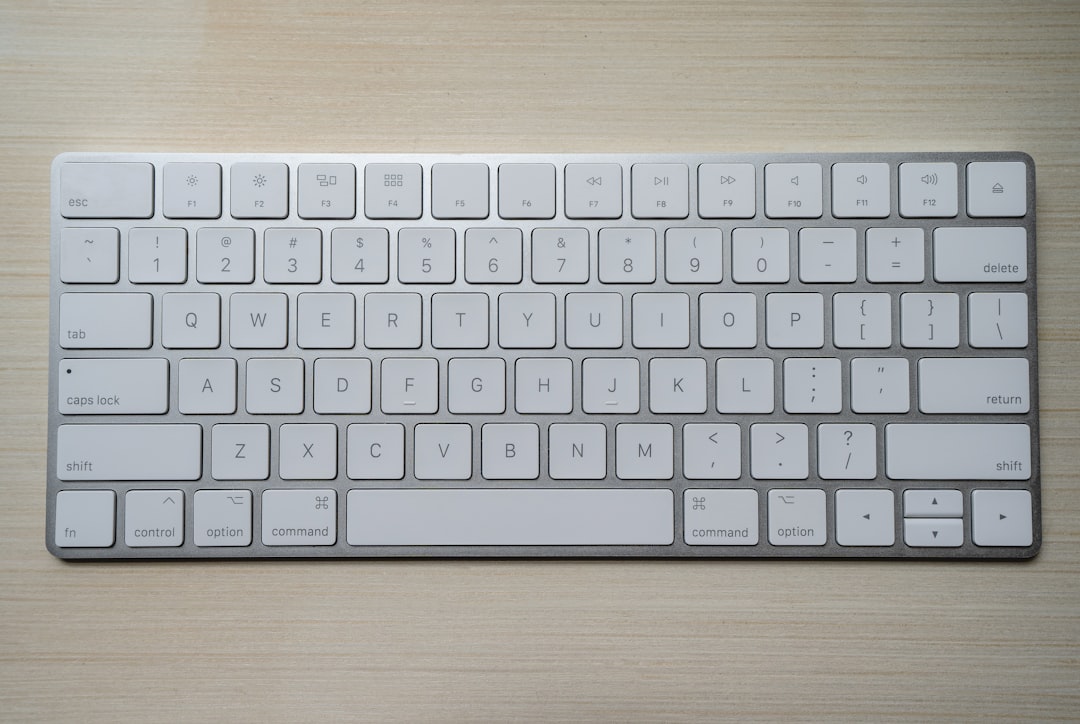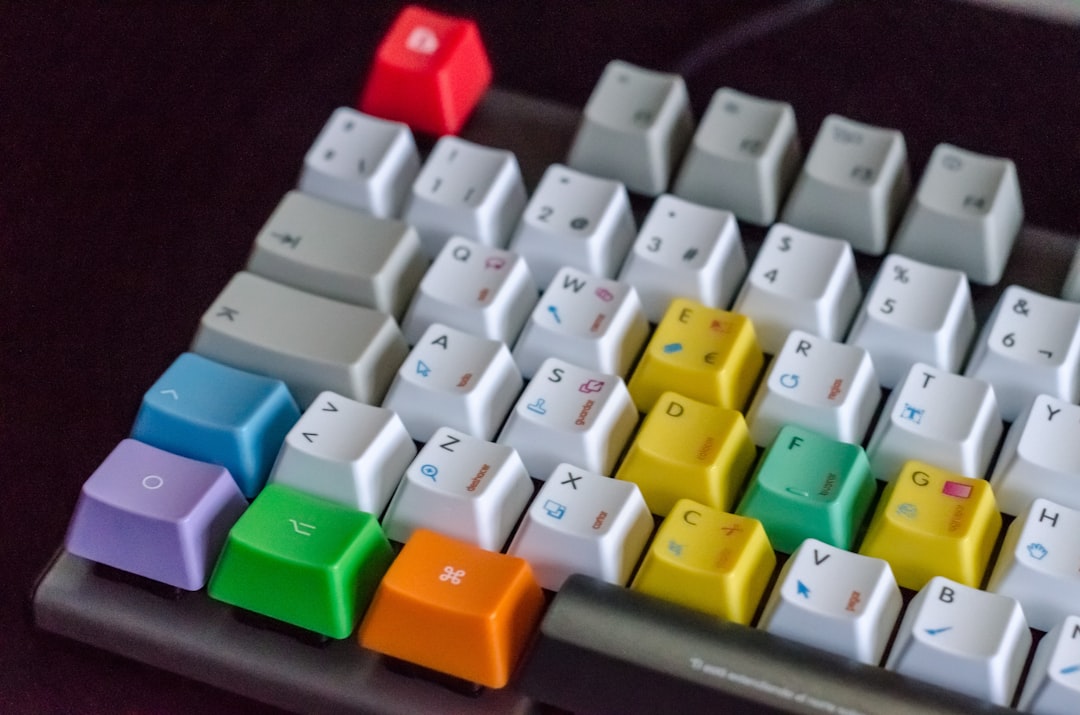Quick Keyboard Shortcuts for Typing the Registered Trademark Symbol Across Devices
Quick Keyboard Shortcuts for Typing the Registered Trademark Symbol Across Devices - Windows Alt Code Method for Typing ®
The Alt Code method for typing the registered trademark symbol (®) on Windows is fairly simple. Hold down the Alt key and type 0174 on the numeric keypad - that's it. You need to make sure Num Lock is on, though. It’s a basic but effective technique that relies on a feature most Windows users have. This method is convenient because it’s consistent across many applications. If you're working within Microsoft Word, there's a dedicated shortcut: Ctrl + Alt + R. This alternative is worth remembering.
While these methods are reliable, you might find the Character Map tool or your word processor's built-in symbol library helpful. These resources can be useful for typing a wider range of special characters. If you lack a numeric keypad, you could try copy-pasting from one of these sources or an online tool.
The Windows Alt Code method for typing the registered trademark symbol (®) uses the ASCII encoding scheme, where 0174 corresponds to this specific symbol. This method requires holding down the Alt key and typing the numbers on the numeric keypad, a limitation for laptops without dedicated number keys. It's important to note that the Alt Code function is sensitive to regional settings, potentially leading to inconsistent results if these settings differ across devices. Interestingly, while many associate Alt Codes with Windows, other operating systems, like macOS, utilize similar input methods with their own graphical interfaces. For those requiring frequent use of special characters, the need to memorize multiple codes can make this approach inefficient. Additionally, software systems like text processors sometimes automatically convert the plain 'R' in parentheses to the registered trademark symbol, rendering the Alt Code method redundant in such cases. The use of Alt Codes represents just one method of conveying trademarked content, with various industries and contexts often implementing specific typography and text styling guidelines. While the Alt Code method can be convenient for some, modern text editing software is increasingly incorporating icons and symbols directly into their text interfaces, potentially reducing reliance on keyboard shortcuts and prompting questions about the future relevance of Alt Codes.
Quick Keyboard Shortcuts for Typing the Registered Trademark Symbol Across Devices - Mac Keyboard Shortcut for Registered Trademark Symbol
Typing the registered trademark symbol (®) on a Mac is a simple task thanks to a handy keyboard shortcut. Just hold down the Option key and press the letter 'R'. This shortcut works seamlessly in a variety of applications, making it a quick and convenient way to insert the symbol without any extra steps. If you need to insert other special characters, the Mac's Character Viewer can be accessed by pressing Command + Control + Space, offering a wide array of symbols to choose from. Knowing this shortcut can greatly improve your efficiency when working on a Mac, especially if you find yourself using trademark symbols frequently.
The Mac keyboard shortcut for the registered trademark symbol (®) is Option + R. It's a remarkably simple combination, letting you quickly access the symbol without hunting through menus or character maps. This shortcut utilizes the Option key, previously called "Alt" on other systems, showcasing its versatility beyond basic modifier duties.
The registered trademark symbol itself, with its roots in US law from 1946, is more than just a visual element. It indicates that the associated product or service has met specific federal requirements, offering protection against trademark infringement. However, the effectiveness of the Option + R shortcut isn't guaranteed across all applications. Older software may not recognize it, prompting the need for alternative methods, like using the Character Viewer, which is a handy tool for accessing a vast library of symbols.
You'll also find that the Option key can clash with function keys if they haven't been properly configured in System Preferences, which can lead to inconsistent results. It's worth noting that while most Mac users likely rely on the Option + R shortcut for frequent use of the registered trademark symbol, some might prefer customizing their own keyboard shortcuts for greater efficiency. Ultimately, the shortcut is a helpful tool, but it's important to be aware of its limitations and the alternative methods available for entering this important symbol.
Quick Keyboard Shortcuts for Typing the Registered Trademark Symbol Across Devices - Microsoft Word Unicode Input Technique
Microsoft Word has a built-in Unicode input technique that's a powerful way to insert a variety of special characters, including the Registered Trademark Symbol (®). It's simple: you type the character code and then press "Alt + X." The code magically transforms into the corresponding symbol. This makes it faster to add special characters to your documents and helps streamline your work.
For those who are comfortable with hexadecimal values, there's also a way to use those to add Unicode characters. This opens up even more possibilities, but it does require memorizing the hexadecimal values, which some users might find challenging.
It's interesting to consider the future of these input techniques. As document formats evolve and more software features are built-in, we might see more direct ways to access special characters. This could mean less reliance on Unicode input techniques and potentially new ways to insert symbols in the future.
The Unicode system, developed in the late 1980s, aims to standardize character encoding across different computing systems. Today, it encompasses over 143,000 characters, supporting not only letters but also symbols, emojis, and scripts from various languages. It's this expansive reach that makes it an intriguing topic for someone like me, an engineer interested in the nuances of language and technology.
In Microsoft Word, you can type special characters, like the registered trademark symbol (®), by typing “00AE” and then pressing Alt + X. This method demonstrates the flexibility of Unicode, providing a distinct advantage over the limitations of traditional ASCII encoding. The ability to seamlessly switch between different character sets is particularly appealing, especially when dealing with technical documentation.
Unicode fosters enhanced compatibility across various platforms. Although the registered trademark symbol might appear differently on different operating systems, the correct character will display as long as the font supports it. This ensures consistency in presentation, even if the underlying code might vary.
One of the key strengths of Unicode lies in its support for multiple languages. Microsoft Word leverages this feature to enable users to easily type characters from different scripts. This is immensely helpful for engineers who collaborate across diverse international contexts and need to utilize a wide range of characters, including technical symbols.
Despite the significant advantages, Unicode isn't without its quirks. Not all fonts support every Unicode character. Consequently, you might find a square box replacing a desired symbol if the font doesn't include it. This can pose a challenge in maintaining consistent visual presentations.
Microsoft Word, being a resourceful application, includes a ‘Symbol’ dialog that allows browsing through various Unicode segments. This feature makes it simpler to locate and insert lesser-known characters without needing to memorize input codes.
The Unicode standard is continuously updated, and Microsoft Word's integration ensures that users have access to new characters as they become available. This makes it a particularly useful tool for documenting evolving technologies and staying at the forefront of advancements.
Unicode input techniques in Microsoft Word even enhance accessibility by providing a wide array of character sets, including symbols catering to individuals with specific needs. These symbols might encompass industry-specific icons, not typically available through standard keyboard shortcuts.
Additionally, characters typed using Unicode can significantly improve the accuracy of text-to-speech applications, improving readability and reducing misunderstandings in technical documentation.
However, using Unicode input can lead to conflicts with formatting tools within Word. Auto-correct features or specific paragraph styles might override automated Unicode inputs, so engineers must pay close attention to formatting during document creation.
In summary, while Unicode presents a robust system for standardizing character encoding, it also highlights the complex interplay between software, fonts, and accessibility features. The impact of Unicode is profound, shaping how we interact with language and technology. This continued evolution will undoubtedly spark further research and development, making the use of special characters in software like Word increasingly seamless and intuitive.
Quick Keyboard Shortcuts for Typing the Registered Trademark Symbol Across Devices - iOS Text Replacement Feature for ® Symbol
The iOS text replacement feature allows you to quickly type the registered trademark symbol (®) by creating a custom keyboard shortcut. You can access this feature in Settings, then Keyboard, and then Text Replacement. From there, you can set up a new shortcut where you type "®" in the "Phrase" field and a word like "reg" in the "Shortcut" field. This lets you type "reg" and it will automatically be replaced with the ® symbol. This feature works consistently across all your Apple devices, making it a convenient way to insert the ® symbol without having to look for it in the special characters menu.
On iOS devices, you can use the text replacement feature to make typing the registered trademark symbol (®) much faster. It's essentially a shortcut that replaces a word with a symbol, which is useful for tasks like writing legal documents or marketing materials.
To set up this shortcut, you go into the settings of the iOS keyboard and add a new text replacement. For example, you can use "rtrademark" as your shortcut that will automatically be replaced with the ® symbol whenever you type it.
This feature showcases Apple's focus on simplifying user interfaces by allowing common symbols to be accessed directly through the keyboard. However, there are some potential drawbacks. If you define a shortcut that's too general, it might accidentally replace other instances of the shortcut, such as if "TM" is set for the trademark symbol, it might unintentionally replace other intended uses of "TM" in your typing.
Also, while text replacement is a native iOS feature, not every app will support it, potentially limiting its usefulness.
Even though the text replacement feature relies on users remembering their defined shortcuts, the idea is to reduce cognitive load by allowing users to create muscle memory around specific shortcuts rather than having to remember complicated input sequences. Another plus is that these text replacements sync across all of your Apple devices, so the shortcut you create on your iPhone will also work on your iPad.
While the text replacement feature is an effective tool, it's not without its limitations. For instance, if you forget your shortcuts, the tool loses its value. And since this feature is dependent on user behavior, its effectiveness can vary.
Also, since the text replacement feature can be integrated with Siri, you can use voice commands to insert shortcuts, but this can be problematic if your pronunciation isn't clear or Siri doesn't understand standard terminology.
Ultimately, while the text replacement feature is a helpful tool for typing common symbols, it's crucial to remember its limitations. If you rely solely on this feature, you might lose your ability to type symbols manually. This could cause problems when you're working with tools that don't support the feature.
Quick Keyboard Shortcuts for Typing the Registered Trademark Symbol Across Devices - Android Character Map and Emoji Keyboard Approach
Android phones and tablets offer a few ways to type the registered trademark symbol (®). The standard keyboard has a symbols page you can access that includes the registered trademark symbol. If you use the Gboard keyboard, it allows you to access special characters by pressing and holding certain keys, including the period key. Finally, you can use an emoji keyboard which is often the fastest way to locate symbols you need. It's worth noting that not all keyboards on Android work exactly the same way, so it might take a bit of experimentation to find what works best for you. While these keyboard features provide convenient access to special characters, they are not always foolproof, so you might still find yourself looking for the registered trademark symbol in some cases.
Android's approach to typing the registered trademark symbol (®) is fascinating and presents a mix of convenience and complexity. While Android devices come with a built-in Character Map, which offers a broad array of symbols, it's often overshadowed by other input methods available on the keyboard. Gboard, the default keyboard on many Android phones, allows for gestures, voice input, and even drawing characters, catering to a wide range of user preferences.
The inclusion of emojis in the keyboard is intriguing. It allows users to combine symbols like ® with graphic icons, opening new avenues for visual communication, particularly in marketing. However, this reliance on emojis for conveying trademarked content can also be seen as a sign of the times – a move towards visual communication that might not be as universally understood as traditional text.
It's important to acknowledge that Android's approach isn't uniform. The availability of symbols within the Character Map can vary across devices and regions. This variability can lead to inconsistencies when trying to access the ® symbol, highlighting the need for users to understand the specific capabilities of their devices.
Customization is a strong point of Android. Many devices allow users to personalize their keyboards, adding shortcuts for frequently used symbols like ®. However, implementing these customizations can vary significantly depending on the keyboard manufacturer. This variability adds another layer of complexity to the Android landscape.
Accessibility is also a key element of Android. Voice recognition features allow users with disabilities to insert symbols through voice commands, making communication more accessible.
Android's keyboard system is built upon Unicode, a vast library containing over 1.1 million characters from various languages and symbols. This comprehensive library ensures that users can access the ® symbol regardless of the language they're typing.
However, the presence of numerous third-party keyboard apps introduces further variations in how users input special characters. These apps often offer more personalized and intuitive methods for inserting symbols.
In addition, some Android keyboards utilize predictive text and auto-suggest features, recognizing terms commonly used with the ® symbol. This streamlines the insertion process, but it can also lead to accidental substitutions if the keyboard isn't configured properly.
While Android offers robust features for accessing special characters, there are still cross-platform discrepancies that users need to be aware of. When transferring documents containing special characters between Android and other operating systems, formatting and encoding standards can present challenges.
The Android approach to special characters like ® is a complex one, offering a mix of convenience and complexity. As the Android ecosystem continues to evolve, we can expect to see even more sophisticated and intuitive ways for users to access and utilize special characters in the future.
Quick Keyboard Shortcuts for Typing the Registered Trademark Symbol Across Devices - HTML Code for Web Documents and Emails
In web documents and emails, you can insert the registered trademark symbol (®) using HTML entities. This means using the code `®` or `®` to represent the symbol. This simple method ensures that the symbol displays correctly across different browsers and devices, a key consideration for web developers. It's important to be mindful of accessibility and coding best practices when adding special characters like this, as it ensures the integrity and quality of your document for the viewer. Understanding how to use HTML code for special characters remains essential for both casual users and professionals who want to create effective digital communications.
As someone always digging into how things work, I find HTML's world fascinating, especially when it comes to emails. While web documents use tags like ``, `
`, and `` to define their structure and how browsers should display them, emails introduce a whole new layer of complexity. Email clients are notoriously finicky about how they interpret HTML, meaning that what looks perfect in one client might look like a mess in another.This inconsistency extends to styling too. Cascading Style Sheets (CSS), the standard way to style web pages, are often handled differently in emails. Most clients have limited support for advanced CSS, requiring a minimalist approach to create visually appealing emails. This is why you often see inline CSS in emails - it's a way to make sure the styles are applied directly to each element, bypassing the potential problems with external stylesheets.
Another important consideration is the "Doctype declaration" - that line at the top of an HTML file that tells browsers how to interpret the document. In web pages, this is crucial for modern layouts, and you'll always find `` for HTML5 documents.
And then there are the special characters. Remember that registered trademark symbol (®)? In HTML, it's represented as `®`. This encoding ensures that the symbol displays correctly across various browsers and platforms.
HTML also takes accessibility into account. Things like the `alt` attribute for images and ARIA roles help make web content accessible to users with disabilities, ensuring that content is presented correctly to assistive technologies.
But here's the thing: even if you use the same HTML code, it can be rendered differently in browsers and email clients. Browsers are generally more forgiving, while email clients can strip out certain elements, causing formatting issues.
The limitations extend to JavaScript, which doesn't always work in emails. This means that creating dynamic content within emails can be a real challenge, forcing developers to rely on static patterns.
And despite the rise of CSS for layout, you'll still find tables heavily used in emails. It's a legacy thing, used for compatibility across various clients to ensure stable layout, reducing the chance of malformed designs.
So while the core concepts of HTML are familiar, emails require a nuanced approach. This constant negotiation between what's possible in HTML and how each email client handles it makes this area a really interesting challenge for anyone working with web content.
More Posts from aitrademarkreview.com:
- →AI Innovation Hub How A&E Business Services Inc Navigates Trademark Protection in Ashburn's Tech Corridor
- →Figgie International's Voice Cloning: Unpacking the Technology's Impact
- →Rochester's Flower City Logo A Trademark Analysis of Dual Industry Heritage
- →AI-Powered Image Recognition Revolutionizing Copyright Protection for Photographers in 2024
- →7 Lesser-Known Public Domain Films Impacting Trademark Law in 2024
- →The Resurgence of Screaming Yellow Zonkers Trademark Implications of a Nostalgic Snack Revival




